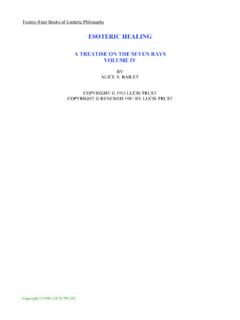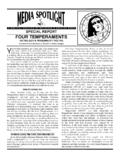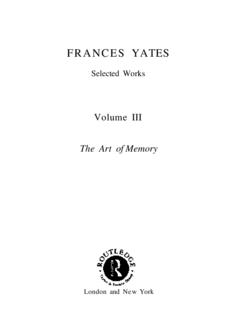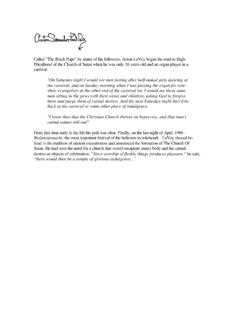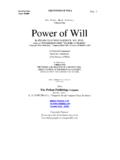Transcription of INTRODUCTION - MetaphysicSpirit.com
1 INTRODUCTION Witchcraft is not merely legendary; it was, and is, real. It is not extinct; it is alive and prospering. Since the last laws against Witchcraft were repealed (as recently as the 1950s), Witches have been able to come out into the open and show themselves for what they are. And what are they? They are intelligent, community-conscious, thoughtful men and women of TODAY. Witchcraft is not a step backwards; a retreat into a more superstition-filled time. Far from it. It is a step forward. Witchcraft is a religion far more relevant to the times than the vast majority of the established churches.
2 It is the acceptance of personal and social responsibility. It is acknowledgement of a holistic universe and a means towards a raising of consciousness. Equal rights; feminism; ecology; attunement; brotherly/sisterly love; planetary care these are all part and parcel of Witchcraft, the old yet new religion. The above is certainly not what the average person thinks of in relation to "Witchcraft". No; the misconceptions are deeply ingrained, from centuries of propaganda. How and why these misconceptions came about will be examined later. With the spreading news of Witchcraft what it is; its relevance in the world today comes "The Seeker".
3 If there is this alternative to the conventional religions, this modern, forward-looking approach to life known as "Witchcraft", then how does one become a part of it? There, for many, is the snag. General information on the Old Religion valid information, from the Witches themselves is available, but entry into the order is not. The vast majority of covens (groups of Witches) are still wary enough that they do not throw open their doors and welcome all and sundry. They are happy to straighten the misconceptions, but they do not proselytize. This leads many would-be Witches, out of sheer frustration, to simply declare themselves "Witches" and start their own practices.
4 In doing so they draw on any, and oftimes all, available sources. The danger here is that they do not know what is valid and relevant and what is not. Unfortunately there are now many such covens, operating with large chunks of Ceremonial Magick happily mixed-in with smatterings of Satanism and odds and ends of Voodoo together with Amerindian lore. Witchcraft is a very "loose" religion, in terms of ritual practices, but it does have certain basic tenets and there are established ritual patterns to be adhered to. The purpose of this book is to give this necessary information. With it, you as an individual or (with like-minded friends) as a group can then either do your own thing, happy in the knowledge that it is at least as valid as any of the more established traditions, or you can, on locating a coven, become an initiated participant with training and knowledge as good as (if not better than) any of the other coven members.
5 In Christianity there are many denominations ( Episcopalian, Roman Catholic, Baptist, Methodist). So it is in Witchcraft. Just as there is no one religion that is right for all people, there is no one denomination of Witchcraft that is right for all Witches. And that is as it should be. We are all different. Our backgrounds both ethnic and social vary greatly. It has often been said that there are many paths, but they all lead to the same center. With so many paths, then, you are able to find the right one for YOU; the one path you can travel comfortably and securely. To be of the most use to you, the information I give in this book the training you will get is non-denominational.
6 I take examples from different traditions ( Gardnerian, Saxon, Alexandrian, Scottish), giving you both general information and specifics. This is drawn from my more than twenty years active participation in the Craft, and nearly twice that in the occult generally. By the time you have finished this training (presuming that you take it seriously), you will be the equivalent of the Third Degree, in Gardnerian or similar. From there you can then, as I have said, go on to other perhaps more specific training if you wish, in the sense of being tailored to a particular tradition. But from this present work you can get all of the basics and build from an excellent foundation.
7 This is a it is something you must work through. Consequently, rather than Chapters, I have divided it into Lessons. At the end of each lesson you will find workbook exercises. At the end of the book in Appendix B you will find examination questions for each lesson. Read through each lesson. Read and absorb. Read through two or three times if necessary. Go back and pay special attention to anything you find was not easily absorbed. When you are finally happy with what you have learned, answer the examination questions. Answer in your own words, without referring back to the text. In this way you can see what has sunk in and what has not.
8 Do not go on to the next lesson until you are completely happy with the previous one. Answers to the questions are to be found in Appendix C. The book has been carefully put together in specific order. Don't try to jump ahead to "more exciting" lessons .. you may well find that you don't have the necessary basics for them! When you have carefully worked through the entire book, then will be the time to go back and dip into it as a refresher. This book is based on the very successful Seax-Wica Seminary course that was enj oyed by over a thousand students worldwide. From that experience I know that the formula works, and works well. I would hasten to add that while based on that course, this \ present work is not the same course.
9 The Seax-Wica course was designed specifically for \ the Saxon tradition; this is not. There is some duplication of the more general Craft material, yes, but not enough that a prior student of the Seminary course could not also enjoy this book. So, if you are a serious student of Witchcraft, or Wicca, either as a would-be practitioner or as one purely academically interested, then I welcome you. I hope you get as much out of this material as did my previous students. - Bright Blessings Raymond Buckland San Diego, California INTRODUCTION LESSON ONE 1 The History and philosophy of Witchcraft History and Development.
10 Persecutions. Re-emergence. The philosophy of Witchcraft. Principles of Wiccan Belief. The Power Within. Spells and Charms. LESSON TWO 13 Beliefs Deities; The God and Goddess of Witchcraft; Rein-carnation; Retribution; Between Lives. Your Temple. Your Altar and its Furniture. Magick an INTRODUCTION . LESSON THREE 27 Tools, Clothing and Names Working Tools; Knife; Marking in Metal; Sword; Other Tools; Dress; Jewelry; Horned Helmet. In-scriptions. Your Witch Name. LESSON FOUR 41 Getting Started Rites of Passage. Circles. Self-Dedication. Coven Initiation. LESSON FIVE 53 Covens and Rituals *i Covens and Degrees.










